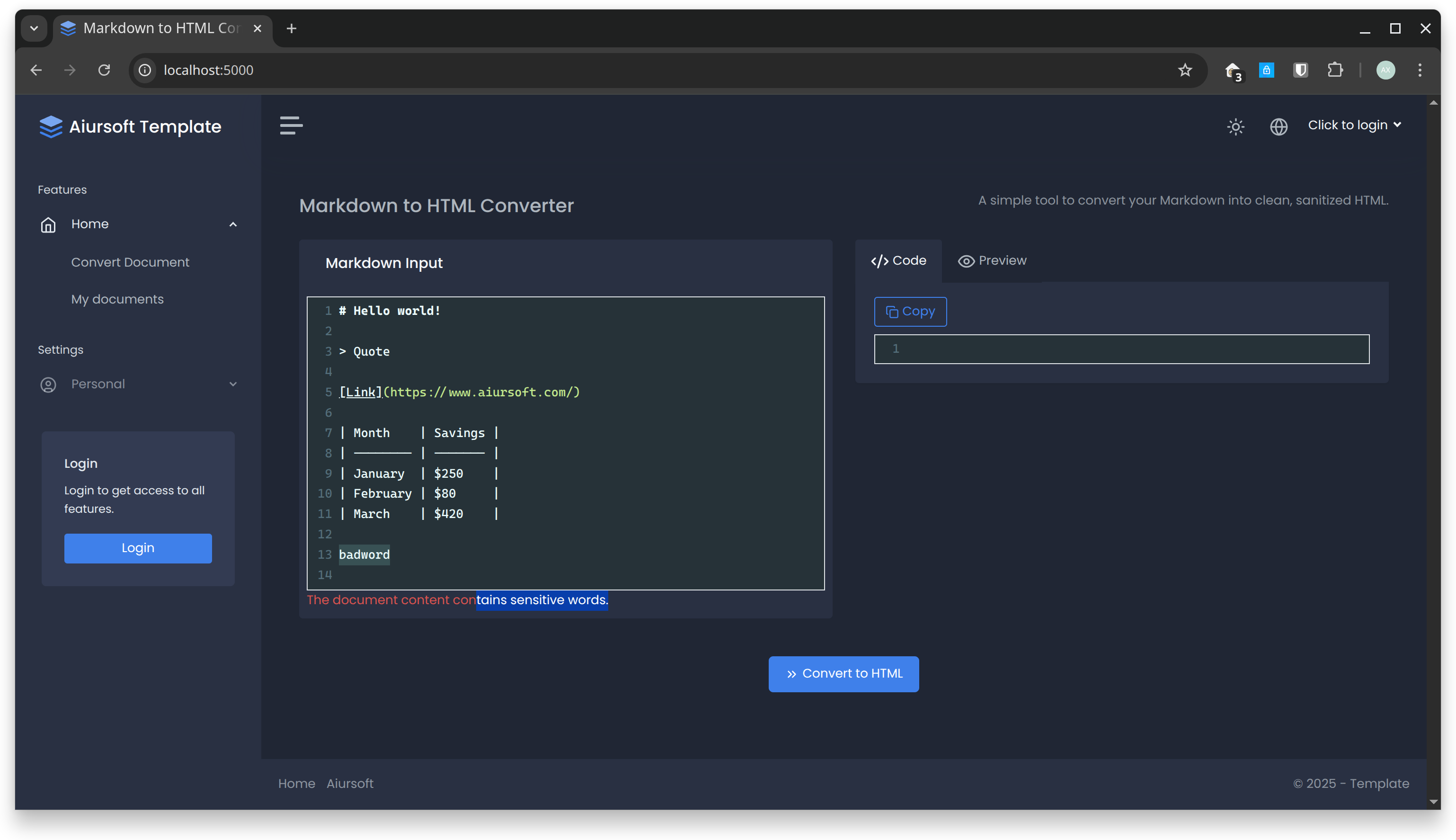Aiursoft Template Tutorial - Step 8 - 添加自定义验证

在前面的步骤中,我们已经广泛地使用了 ASP.NET Core 内置的验证特性,如 [Required] 和 [MaxLength],来确保用户输入数据的基本有效性。这些特性与 ModelState 紧密集成,极大地简化了数据验证流程。
然而,在实际开发中,我们常常会遇到更复杂的验证需求,内置的特性无法满足。例如,我们可能需要:
- 验证用户输入的文档标题和内容是否包含不当言论或敏感词。
- 验证用户名是否在系统中已经存在。
- 验证用户输入的日期范围是否合乎逻辑。
在这一章,我们将学习如何创建自定义的验证特性(Validation Attribute),并以一个敏感词过滤器为例,来为我们的应用添加更高级的验证逻辑。
Step 8.1 - 创建敏感词过滤服务
一个好的设计实践是将业务逻辑与验证规则本身分离。直接将敏感词列表硬编码在验证特性中是不灵活且难以维护的。因此,我们首先创建一个专门的服务来处理敏感词的检测。
在 ./src/MyOrg.MarkToHtml/Services/ 目录下,创建一个新文件 BadWordFilterService.cs,并添加以下代码:
using Aiursoft.Scanner.Abstractions;
namespace MyOrg.MarkToHtml.Services;
public class BadWordFilterService : ISingletonDependency
{
// In a real-world application, this list might come from a database or a configuration file.
private readonly HashSet<string> _badWords = new(StringComparer.OrdinalIgnoreCase)
{
"badword",
"sensitive"
};
public bool ContainsBadWord(string? text)
{
if (string.IsNullOrWhiteSpace(text))
{
return false;
}
return _badWords.Any(badWord => text.Contains(badWord, StringComparison.OrdinalIgnoreCase));
}
}
在这个服务中,我们硬编码了一个包含几个示例敏感词的列表。在真实的生产环境中,这个列表可能来自配置文件、数据库或外部API。ContainsBadWord 方法负责检查传入的文本是否包含列表中的任何一个词。
我们实现了 ISingletonDependency 接口,这意味着 Aiursoft Scanner 会自动将其注册为单例 (Singleton) 服务。这很合适,因为敏感词列表在应用生命周期内是固定的,无需为每个请求都重新创建。
Step 8.2 - 创建自定义验证特性
现在我们有了业务逻辑服务,接下来就可以创建自定义验证特性了。这个特性将使用我们刚刚创建的服务来执行验证。
首先,在项目根目录下创建一个新文件夹 Attributes。
然后,在 ./src/MyOrg.MarkToHtml/Attributes/ 目录下,创建一个新文件 NoBadWordsAttribute.cs,并添加以下代码:
using System.ComponentModel.DataAnnotations;
using MyOrg.MarkToHtml.Services;
namespace MyOrg.MarkToHtml.Attributes;
[AttributeUsage(AttributeTargets.Property | AttributeTargets.Field | AttributeTargets.Parameter, AllowMultiple = false)]
public class NoBadWordsAttribute : ValidationAttribute
{
protected override ValidationResult? IsValid(object? value, ValidationContext validationContext)
{
// Get the service from the dependency injection container.
var badWordFilter = validationContext.GetService(typeof(BadWordFilterService)) as BadWordFilterService;
if (badWordFilter == null)
{
// This should not happen if the service is registered correctly.
throw new InvalidOperationException("BadWordFilterService is not registered.");
}
if (value is not string stringValue)
{
// This validator only applies to strings.
return ValidationResult.Success;
}
if (badWordFilter.ContainsBadWord(stringValue))
{
// If a bad word is found, return a validation error.
return new ValidationResult(ErrorMessage ?? $"The field {validationContext.DisplayName} contains inappropriate content.");
}
// If no bad words are found, the validation is successful.
return ValidationResult.Success;
}
}
理解 ValidationAttribute
ValidationAttribute 是所有验证特性的基类。通过继承它并重写 IsValid 方法,我们就可以定义自己的验证规则。
我们选择重写 IsValid(object? value, ValidationContext validationContext) 这个重载版本,因为它更强大。validationContext 参数不仅提供了关于被验证属性的上下文信息(如属性名 DisplayName),还能让我们访问依赖注入容器 (validationContext.GetService),从而获取到像 BadWordFilterService 这样的服务实例。
这段代码的逻辑很清晰:
- 从依赖注入容器中获取
BadWordFilterService。 - 检查被验证的值是否为字符串。
- 调用服务的
ContainsBadWord方法进行检查。 - 如果检测到敏感词,则返回一个
ValidationResult实例,表示验证失败。否则,返回ValidationResult.Success表示验证通过。
Step 8.3 - 在 ViewModel 中应用新特性
现在我们已经创建了自定义验证特性,可以像使用 [Required] 一样,将它应用到我们的 ViewModel 中了。
打开 ./src/MyOrg.MarkToHtml/Models/HomeViewModels/IndexViewModel.cs 文件,为 Title 和 InputMarkdown 属性添加 [NoBadWords] 特性:
using System.ComponentModel.DataAnnotations;
using Aiursoft.UiStack.Layout;
using MyOrg.MarkToHtml.Attributes; // Add this using directive
namespace MyOrg.MarkToHtml.Models.HomeViewModels;
public class IndexViewModel : UiStackLayoutViewModel
{
// ... other properties ...
[MaxLength(100)]
[NoBadWords(ErrorMessage = "The document title contains sensitive words.")]
public string? Title { get; set; }
[Required(ErrorMessage = "Please input your markdown content!")]
[NoBadWords(ErrorMessage = "The document content contains sensitive words.")]
public string InputMarkdown { get; set; } = // ... default value ...
// ... other properties ...
}
通过添加 [NoBadWords],我们告诉 ASP.NET Core 在处理表单提交时,除了执行已有的验证外,还要执行我们自定义的敏感词验证。我们还为每个特性提供了自定义的错误消息。
Step 8.4 - 测试自定义验证
一切准备就绪!现在我们可以来测试新的验证功能了。
- 重新编译并运行项目。
- 登录一个账户(例如
admin/admin123)。 - 导航到创建文档页面 (
/Home/Index) 或编辑一个已有的文档。 - 在标题或内容输入框中,输入我们在
BadWordFilterService中定义的敏感词之一,例如 "this is a badword"。 - 点击“Convert and save”按钮提交表单。
你会发现页面刷新了,但在输入框下方出现了我们定义的错误消息:“The document content contains sensitive words.”。
这证明了我们的自定义验证逻辑已成功触发。在 HomeController 的 Index POST 方法中,ModelState.IsValid 因为我们的自定义验证失败而返回 false,从而阻止了后续的数据库保存操作,并将用户带回了带有错误提示的表单页面。
结语
恭喜你完成了第八步!你现在已经掌握了一项非常强大的技能:创建与业务逻辑紧密集成的自定义验证规则。
通过将验证逻辑封装在自定义的 ValidationAttribute 中,并利用依赖注入来调用后端服务,你可以实现几乎任何复杂的验证需求,同时保持代码的整洁、模块化和可维护性。最重要的是这样做可以避免在代码中散布大量难以维护的 if 语句,从而提升代码可读性和质量。
这个模式不仅限于敏感词过滤,还可以应用于验证数据唯一性、检查业务规则、调用第三方API验证等多种场景,极大地增强了应用的健壮性。